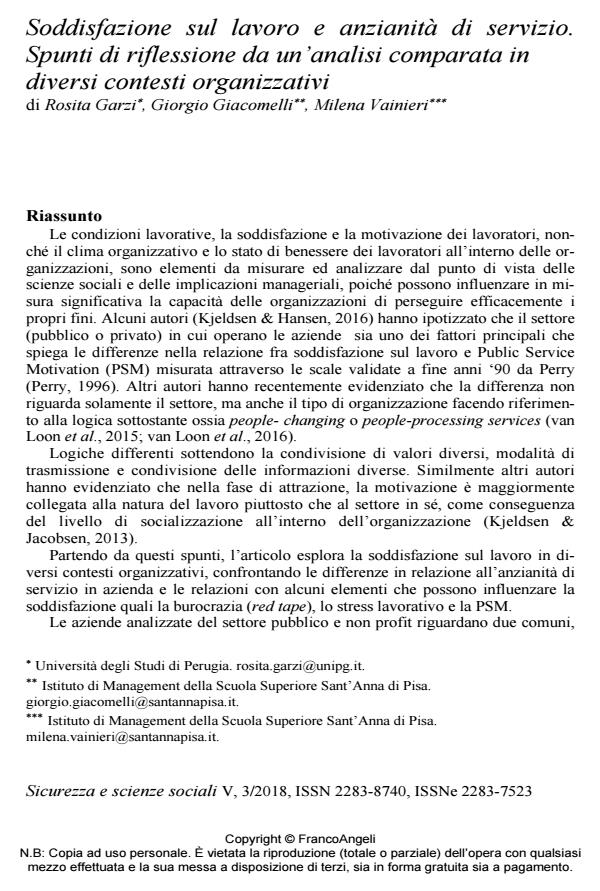Soddisfazione sul lavoro e anzianità di servizio. Spunti di riflessione da un’analisi comparata in diversi contesti organizzativi
Journal title SICUREZZA E SCIENZE SOCIALI
Author/s Rosita Garzi, Giorgio Giacomelli, Milena Vainieri
Publishing Year 2019 Issue 2018/3
Language Italian Pages 17 P. 37-53 File size 203 KB
DOI 10.3280/SISS2018-003004
DOI is like a bar code for intellectual property: to have more infomation
click here
Below, you can see the article first page
If you want to buy this article in PDF format, you can do it, following the instructions to buy download credits

FrancoAngeli is member of Publishers International Linking Association, Inc (PILA), a not-for-profit association which run the CrossRef service enabling links to and from online scholarly content.
Working conditions, worker satisfaction and motivation, as well as the organisational climate and well-being of workers within organisations, are elements to measured and analysed from managerial and social sciences, as they can significantly influence the ability of organisations to effectively pursue their goals. Some authors (Kjeldsen & Hansen, 2016) suggested that the sector (public or private) in which organizations operate is one of the main factors explaining the differences in the relationship between job satisfaction and Public Service Motivation (PSM) as measured by the scale validated in the late 1990s by Perry (Perry, 1996). Other authors have recently pointed out that the difference lies also in the type of organization referring to the underlying logic, i.e. people-changing or people-processing services (van Loon et al., 2015; van Loon et al., 2016). Different logics imply different values and information sharing processes. Simi-larly, other authors have pointed out that in the phase of attraction, the motivation is more related to the nature of the work than to the sector itself, as a consequence of the level of socialization within the organization (Kjeldsen & Jacobsen, 2013). Starting from these ideas, the article explores job satisfaction in different organizational contexts and its relationship with some elements that can affect satisfaction such as red tape, work stress and PSM also analyzing the responses related to the seniority. The organisations analysed in the public and non-profit sectors concern two municipalities, two social cooperatives and three healthcare companies that insist on the Umbrian territory. All employees of these companies were invited to fill out a questionnaire on climate and organizational well-being in 2016 via CAWI (more information on the questionnaire can be found on Pizzini & Furlan, 2012; Sabina et al., 2016 and Cappello & Garzi, 2017) collecting a total of 2698 questionnaires.
Keywords: Job satisfaction; Public Service Motivation; Organizations; Seniority; Red tape; Work related stress.
- Evaluating Climate between Working Excellence and Organizational Innovation: What Comes First? Isabella Bonacci, Andrea Mazzitelli, Donato Morea, in Sustainability /2020 pp.3340
DOI: 10.3390/su12083340
Rosita Garzi, Giorgio Giacomelli, Milena Vainieri, Soddisfazione sul lavoro e anzianità di servizio. Spunti di riflessione da un’analisi comparata in diversi contesti organizzativi in "SICUREZZA E SCIENZE SOCIALI" 3/2018, pp 37-53, DOI: 10.3280/SISS2018-003004